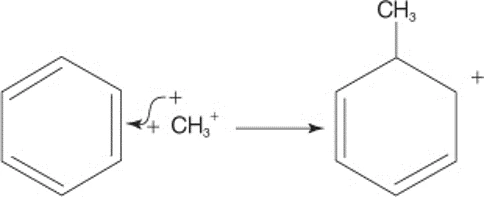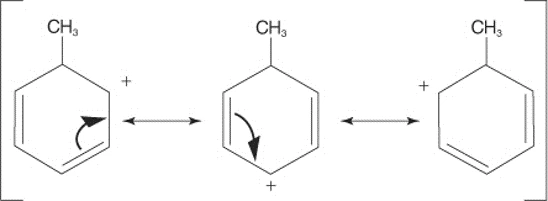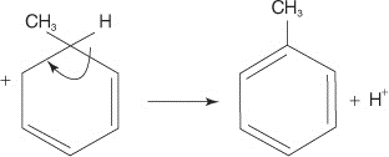FRIEDEL-CRAFTS ALKYLATION
Friedel Crafts Alkylation Reaction
Friedel‐Crafts alkylation reaction involves the addition of an alkyl group to a benzene molecule by an electrophile aromatic substitution.
The mechanism for this reaction commences with the formation of a methyl carbocation from methyl bromide. The carbocation reacts with the π electron system of the benzene to form a nonaromatic carbocation that donates a proton to rebuild the aromaticity of the system.
1. The reaction of methyl chloride with aluminum chloride forms an electrophile.

2. A nonaromatic carbocation is formed when an electrophile attacks the π electron system of the benzene ring

3. The positive charge on the carbocation is delocalized all over the molecule.

4. The aromaticity is restored by the loss of a proton from the atom to which the methyl group has bonded.

5. Lastly, the proton interacts with the AlCl 4 − to regenerate the AlCl3 catalyst and form the product HCl.
H+ + AICI4- → HCI + AICI3
Carbocations can reorganize during the Friedel‐Crafts alkylation reaction, leading to the formation of unpredicted products. For example, the formation of isopropyl benzene by the reaction of propyl chloride with benzene.

The isopropyl benzene is prepared from a rearrangement of the initially formed propyl carbocation to a more stable isopropyl carbocation.

The particular rearrangement is called a 1,2-hydride ion shift. A hydride ion is H−.






Similar Questions
FRIEDEL-CRAFTS ACYLATION
View SolutionFRIEDEL-CRAFTS REACTION:
View SolutionPhenol-Introduction and Methods OF Preparation|| Dow's Process, Sodalime Decarboxylation, Diazotisation, Fenton's Reagent, Fries & Claisen Rearrangement|| Properties OF Phenol, EAS, Reimer Tiemann & Kolbe's Reactions|| Friedel Craft Alkylation and Acylation
View SolutionFriedel Craft Alkylation
View SolutionFriedel Craft Alkylation
View SolutionFriedel Craft Acylation
View SolutionFriedel Craft Acylation
View SolutionSulphonation/Desulphonation Reaction || Friedel Craft Alkylation with Examples and Drawbacks OF Friedel Craft Alkylation and Friedel Craft Acylation
View SolutionFriedel Craft Alkylation and acylation
View SolutionGive reasons for the following in one or two sentences "Nitrobenzene does not undergo Friedel-Craft's alkylation."
View Solution